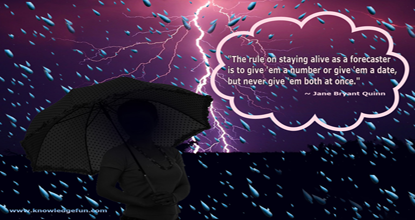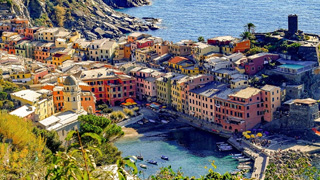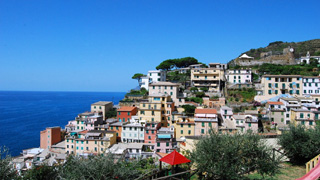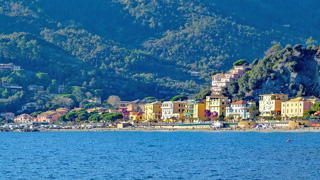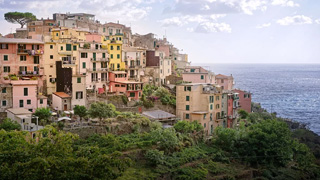Visit Manarola - Delightful Village of the Italian Riviera
Manarola is an impossibly picturesque small village with bright yellow, orange and red houses, part of the municipality of Riomaggiore, in the province of La Spezia, Liguria, northern Italy.
Manarola is the second smallest of the famous Cinque Terre villages frequented by tourists. The Cinque Terre (meaning "Five Lands") is a coastal area within Italy's Riviera Liguria, in the northwest of Italy. Liguria and its capital Genoa are part of the Alps-Mediterranean Euroregion.
The Cinque Terre lies in the west of La Spezia, and comprises five villages: Monterosso al Mare, Vernazza, Corniglia, Manarola, and Riomaggiore clustered on the rugged, steep landscape along the beautiful blue waterline. The coastline, the five villages, and the surrounding hillsides are all part of the Cinque Terre National Park a UNESCO World Heritage Site. Cinque Terre National Park is the smallest national park in Italy at 4,300 acres, but also the densest with 5,000 permanent inhabitants among the five little villages.
Manarola may be the oldest of the villages in the Cinque Terre, with the cornerstone of the church, San Lorenzo, dating from 1338. Manarola and other four villages are of the Cinque Terre are connected by rail and each of the five villages has its own train station. You can also hike the Sentiero Azzurro cliff side hiking trail that links the villages and offers sweeping sea vistas. Another popular tourist attraction in the region is a famous walking trail between Manarola and Riomaggiore called Via dell'Amore ("Love's Trail").
Manarola's primary industries have traditionally been fishing and wine making. The local high quality white dessert wine, called Sciacchetrà is produced in the hills of Cinque Terre and it is the most famous and probably the most important product of this region.
The food in the Cinque Terre area is feast made of popular tasty staples of the region: countless varieties of strictly seasonal fresh fish and other fresh seafood grilled, salted or sauted and served with seasonal vegetables.
Unforgetable local pasta dishes are covered with a tasty sauces made from tomato puree, olive pulp, vegetables and local olive oil. You have to try trenette (narrow, flat, dried pasta from Liguria, similar to both linguine and fettuccine) served with Liguria region’s famous sauce, pesto. Also try Ligurian corzetti (stamped medieval pasta) and pansotti (the typical Ligurian ravioli-style pasta) topped with creamy walnut sauce.
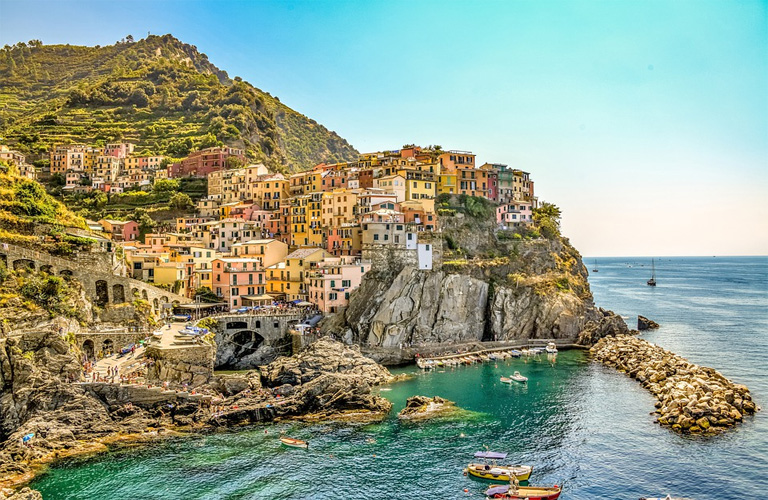
Manarola and its neighboring villages have become popular tourist destinations, particularly in the summer months. Manarola was also celebrated in paintings by Antonio Discovolo (1874–1956).
Cinque Terre is mentioned in documents dating to the 11th century. Monterosso and Vernazza were settled first and the other villages grew later, whilst within the territory of the Republic of Genoa.
Unlike the other villages of the five Cinque Terre, Corniglia is not directly adjacent to the sea. Instead, it is on the top of a promontory about 100 metres high, surrounded on three sides by vineyards and terraces, the fourth side descends steeply to the sea. To reach Corniglia, it is necessary to climb the Lardarina, a long brick flight of steps composed of 33 flights with 382 steps or, otherwise follow a vehicular road that, from the station, leads to the village. Sometimes a small bus runs.
"Travel is fatal to prejudice, bigotry, and narrow mindedness, and many of our people need it sorely on these accounts." ~ Mark Twain
:: Did You Know? ::
Liguria is a region of north-western Italy and its capital is Genoa. Its territory is crossed by the Alps and the Apennines mountains chains. Liguria is bordered by France (Provence-Alpes-Côte d'Azur) to the west, Piedmont to the north, and Emilia-RomagnaTuscany to the east. It lies on the Ligurian Sea. The region is part of the Alps-Mediterranean Euroregion.Genoa was one of the most powerful maritime republics in the Mediterranean from the 12th to the 14th century. Genoese explorer Christopher Columbus was an explorer and colonizer who completed four voyages across the Atlantic Ocean that opened the New World for conquest and permanent European colonization of the Americas. Columbus had embarked with intent to find and develop a westward route to the Far East, but instead discovered a route to the Americas, which were then unknown to the Old World.
The Province of La Spezia is located in the Liguria region of Italy and its capital is the city of La Spezia, the second largest city in the Liguria region, just after Genoa.
Riomaggiore, the most southern village of the five Cinque Terre and the the first village one meets when travelling north from La Spezia is known for its historic character and its wine, produced by the town's vineyards. Riomaggiore's main street is Via Colombo, where numerous restaurants, bars, and shops can be found. Riomaggiore inspired paintings by Telemaco Signorini (1835–1901), one of the artists of the Macchiaioli group.
Vernazza is the fourth village of the five Cinque Terre heading north, has no car traffic, and remains one of the truest "fishing villages" on the Italian Riviera. It is the only natural port of Cinque Terre and is famous for its elegant houses. The first records recognizing Vernazza as a fortified town date to 1080. Referred to as an active maritime base of the Obertenghi, a family of Italian nobility, it was a likely point of departure for naval forces in defence of pirates.
Monterosso al Mare is the westernmost of the five Cinque Terre. It is located at the center of a small natural gulf, protected by a small artificial reef, to the east of Punta Mesco in the Riviera of La Spezia. The town is divided into two distinct parts: the old town and the new town. The two areas are divided by a single tunnel that caters to pedestrians and the very few cars in the town. The local train station is located at Fegina and the beaches are relatively larger compared to the narrow cliffs that characterize the other villages of the Cinque Terre. The beach at Monterosso runs along most of the coast line and is the only extensive sand beach in the Cinque Terre.
"Travel makes one modest, you see what a tiny place you occupy in the world."
~ Gustave Flaubert

